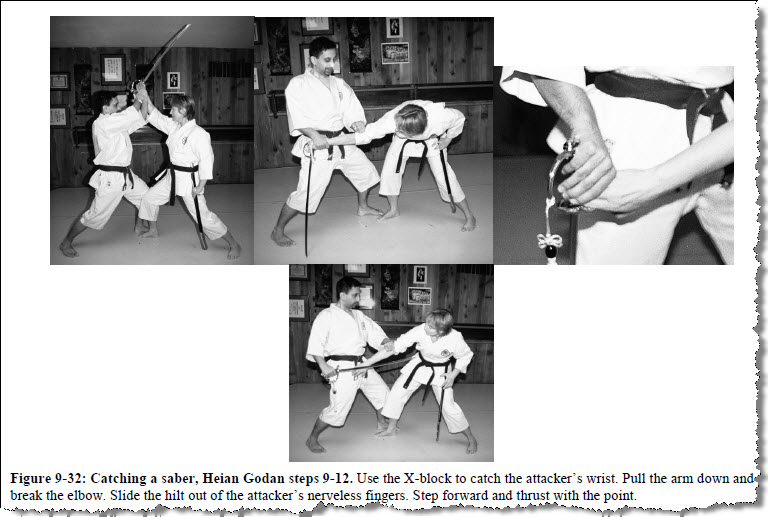Also, "Senjo Kumiuchi," battlefield grappling, and "Kumiuchi Kenden," wrestling over a sword, Serge Mol, Classical Fighting Arts of Japan: A Complete Guide to Koryu Jujutsu, Kodansha, 1970.
Also, "Jinzo Zuki" (knife in kidney), see page 42-43 of U.S. Army Hand-To-Hand Combat: FM 21-150, June 1954.
Also, figures 5-14 and 5-16 of US Army, Combatives Hand to Hand Combat, September 1992.
Also, pages 20-22 of Mashiro's Black Medicine III: Low Blows, Paladin Press, 1981.
Also, "Mune Osae Dori," pages 56-57 of Dennis Palumbo, Techniques of Sandan GI: The Essence of Hakkoryu Jujutsu, Paladin Press, 1993.
Also, "High/Low Frontal Stab," pages 11 and 14 of German Army Command, Defense against English Gangster Methods (Silent Killing), 1942, reprinted by Paladin Press as Silent Killing: Nazi Counters to Fairbairn-Sykes Techniques, 2008.
Step 8-10 of H. Godan are the "X" downblock, the "X" upblock, and the palm-to-palm osae uke (pressing block) motion that flutters down to the right hip. Step 11-12 is the step forward with a left "punch" in mid-step and a right oi zuki and kiai.
Tekubi Shime Waza
Tekubi shime waza means "wrist pain technique." It is George Kirby's name for technique 2-6 of his DVD series.
In step 8 of the kata, the enemy attempts to stab you in the abdomen with his knife, held in his right hand. You frustrate his attack using a "X" downblock. It is important that you place your right hand on top, as in the kata.
The kata moves your hands vertically from the low "X" block to the high one, but that isn't how jujutsu experts perform this move. Instead, take his hand in a big, clockwise circle, rotating out to your left on the way up to step 9's "X" block at the top. At about 9:00 on this clock dial, your right hand can set the jujutsu "pistol grip" on the back of his knife hand, with your right palm against the back of his hand, and your fingers wrapped around the little-finger side of his hand. By the time you get to the top of the circle (step 9), you have already rotated his wrist most of the way into an ikkyo arm bar. Continue the big circle down to the 3:00 position (step 10), pressing your left hand against his elbow to keep his arm straight.
The ikkyo arm bar gives you several options at this point, some of which you should share with your students. For instance, you can put pressure against his wrist, forcing his hand open so that you can take the knife. Or, you can raise his arm upward, creating a shoulder lock, and then use downward pressure on his locked wrist to force him face-down on the floor. Mashiro (Black Medicine III) shows the arm bar followed by a knee-lift (hiza geri) to the face. FM 21-150 (1992) shows the armbar takedown as a knife disarming technique.
Kumiuchi Kenden, Jinzo Zuki
A more deadly option is jinzo zuki, the kidney stab from kumiuchi kenden, the ancient art of wrestling over a sword. It is melodramatic but students love it. From the ikkyo arm bar in step 10, use your left hand to place a new "pistol grip" on his knife hand, this time from below (your palm against the back of his hand, you fingers wrapped around the little-finger edge of his palm). Let go with your right hand and shove your left hand in behind his shoulder blade, placing him in a very painful hammer lock (the "punch" of step 11). This lock is extremely painful and forces him to drop the knife. (This is illustrated nicely in Palumbo's "Mune Osae Dori" at the sandan level, reference above.) If you are adept, you can catch the knife in your right hand. Step 12 is the "front punch and kiai" move. That's when you put Shotokan power behind the knife and ram it into his kidney. The kidney stab is illustrated in most military combatives manuals (references above).
For an unarmed interpretation, you can do use step 11 to spin him around and step 12 as a kidney punch.
Alternate Theory of Step 8-9
Your more exacting students may object that we already used step 8 in the previous cluster. If so, you can satisfy them while teaching an additional valuable lesson.
In the previous cluster we used the "X" downblock of step 8 as a vicious enhanced wristlock. The purpose of this was to force the attacker to drop the knife he had in his left hand. This technique works very well, but a sophisticated attacker may drop the knife into the palm of his right hand and continue to fight. Our students should know that this can happen. (In fact, they should be trained to do it themselves.)
In step 8, you have the opponent's knife hand (the left hand) captured and in severe pain as you twist his wrist in the "X" downblock position. Instead of dropping the knife, he switches the knife to his right hand. He raises the knife overhead and stabs down.
Your response is to follow the kata. Drive upward with the "X" upblock (step 9) and then rotate his arm into the ikkyo lock (step 10). You can proceed to a disarming technique, a pinning technique, or the jinzo zuki as before.
Saber Interpretation
The force of US military men who invaded Shuri Castle in 1853 included fifty naval officers armed with sabers. In Shotokan's Secret, I showed the following sequence of saber-disarming moves. They are essentially the same as the knife-disarming techniques described above. It is just a bigger knife.


